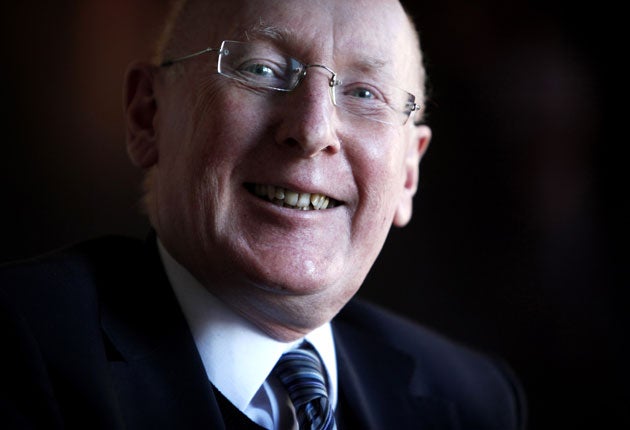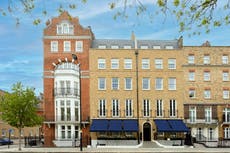Sir Clive Sinclair: Down but never out, the eternal optimist is back
It's been 25 years since the Sinclair C5 was launched and flopped. But its inventor refuses to let these knocks get in the way of his ideas. Jonathan Owen meets Sir Clive Sinclair

Your support helps us to tell the story
From reproductive rights to climate change to Big Tech, The Independent is on the ground when the story is developing. Whether it's investigating the financials of Elon Musk's pro-Trump PAC or producing our latest documentary, 'The A Word', which shines a light on the American women fighting for reproductive rights, we know how important it is to parse out the facts from the messaging.
At such a critical moment in US history, we need reporters on the ground. Your donation allows us to keep sending journalists to speak to both sides of the story.
The Independent is trusted by Americans across the entire political spectrum. And unlike many other quality news outlets, we choose not to lock Americans out of our reporting and analysis with paywalls. We believe quality journalism should be available to everyone, paid for by those who can afford it.
Your support makes all the difference.Some people don't know when to quit. This is common among people who are unusually stupid or preternaturally clever. Sir Clive Sinclair is not stupid. Indeed at one time, he was expected to take over the computer world. He pioneered personal computers in the early 1980s, running a company which employed hundreds and made millions.
A regular guest at No 10, he was given a knighthood on the recommendation of then Prime Minister Margaret Thatcher, and won awards for his business success.
But then he had a dream of electric cars for everyone – cheap environmentally friendly transport. It became a nightmare that almost destroyed him. And now he wants to try again. Today marks the 25th anniversary of the C5's first appearance to an unsuspecting British public. In true British tradition, they hated it.
He wanted to be a latter-day Henry Ford. Instead, Sir Clive saw his fortune disappear and his company ruined by the disastrous launch of the C5 electric vehicle – a plastic, dumbed-down version of the Robin Reliant without the roof and a top speed of 15mph – when it was launched in 1985. Panned by the critics and shunned by the public, before the year was out production had ceased and Sinclair Vehicles went into receivership – the inventor's reputation in ruins.
Now Sir Clive Sinclair claims he is poised to make a comeback with a new plan that could finally see his dream of a successful electric vehicle become a reality.
We meet at his luxury flat overlooking Trafalgar Square, where the one-time multimillionaire, 69, is working on a "single-seat city transport vehicle". Although reluctant to go into details, he reveals that he sought backing at the Frankfurt Motor Show last October. Although he has not found a company to take his idea on, he will not give up.
His philosophy is simple: "The idea that an inventor can come up with some brilliant idea and somebody else will make it all happen is nonsense. If the idea is good enough, it's going to appear pretty crazy to almost everybody. Either you do it yourself or it ain't going to happen."
Such tenacity can be seen in his private life too. His latest relationship reunited him with Angie Bowness, a former beauty queen turned dancer whom he met at Stringfellows in the late 1990s. After a 10-year hiatus, the pair got back together last year and are now engaged. Ms Bowness, 33, works as his PA. A wedding date has yet to be set. Glancing nervously at his fiancée, he chuckles: "I'll wait for my instructions." Clearly irritated, she manages a forced laugh and clears her throat before declining Sir Clive's invitation to join us and disappearing to "make some calls".
The C5 disaster wasn't the only thing that hit Sir Clive hard 25 years ago. His personal life also went into freefall, when he and his wife Anne divorced after more than 20 years of marriage. He embarked on a series of high-profile affairs with younger women including actresses Ruth Kensit, Tricia Walsh and Sally Farmiloe.
Sir Clive bristles at the suggestion that he was going through a mid-life crisis. "No, I don't think so. I just always liked to have a girlfriend and that's what I did."
And he isn't smiling when asked about the recent BBC4 drama Micro Men. Set in the 1980s, it charts the volatile relationship between Sir Clive and his former protégé Chris Curry, who went on to found rival company Acorn Computers. He is played by Alexander Armstrong, who has described Sir Clive as a cross between Albert Einstein and Willy Wonka and portrays a man prone to ashtray-throwing tantrums. "It was a travesty of the truth. It just had no bearing on the truth. It was terrible," he said.
Recent years have seen him repeatedly fail to match his earlier successes, with flops including the Zike, a mini electric bike, and the Zeta, an electric engine that fits on to an ordinary bike.
His latest project, A Bike, is the result of five years of work. A folding bike for commuters, it weighs half as much as anything else on the market, as Sir Clive is quick to point out when I spot one in the corner of the room. It has been plagued with production problems, and while he claims that demand is "colossal" he cannot cite specific figures and refers to a legal matter that prevents him talking about what is "a long and complicated story".
He does not dwell on the past, or so he claims. "You can meet with triumph and disaster. I don't get too high when it's supposed to be looking good and I'm not knocked down when it's not looking so good. I always get on with whatever the situation is and I never feel 'my God that's the end of the world'. I just get on with the next stage." But while he is driven to develop new ideas, it is clear that he has no great love for the business side of things. "I'm not a businessman by nature but we all have to be businesslike in our lives."
Being known for the C5 is "tiresome" and he adds: "It's up to me to correct that."
Looking at the ice-bound water fountains in a bleak Trafalgar Square, he reflects: "You can see what a good time of year it was to launch it." Bursting into laughter, he adds: "It was exactly like this: the ground was covered in snow and we hadn't realised that the batteries virtually packed up in freezing conditions. It was a crazy time to launch it. God knows why I did that.
"It had a rough time, partially my own fault, but it also got a very bad press which didn't help."
But Sir Clive, who describes himself as "the eternal optimist", still thinks he was right. "I think it was a good idea then and I do now, and we sold quite a few thousand and people loved them." But he goes on to confess: "Clearly I should have handled it differently. If I had it could have succeeded." His voice tailing off, he adds: "I rushed at it too much and invested too much in the tooling and I should have gone a bit more gently into it."
Not an easy thing for someone whose passion for inventing gadgets began at the age of six, when captivated by an inventor character on the children's radio programme Larry the Lamb. By the time he was 12 he had designed a one man submarine. Six years later, keen to escape the boredom of school, he opted to go into the world of work rather than to university.
After several years working as a technical journalist, where he spent much of his time developing his own products, Sir Clive left to start up his own electronics business in 1962. By the 1970s he launched the Executive, the world's first pocket calculator, and his fortunes soared with the ZX range of computers in the early 1980s.
He was an inventor with a Midas touch. But the C5 debacle reduced him to something closer to the ill-fated jeweller Gerald Ratner.
Smiling across from me in his front room, wearing a suit and tie that you'd expect to see in the boardroom rather than in someone's home, he insists he is not bitter. The challenge of turning ideas into reality is what motivates him. "I certainly have no desire to be hugely rich. I mean, I have been hugely rich, but that was just something that happened. I want to have enough money obviously, we all do, but I am not concerned about it."
While he admits that there have been "endless problems with all sorts of things" he maintains: "I don't live in the past. I'm always excited by what I'm doing in the present."
When pressed on the things he regrets, the inventor singles out the C5. "That was the big one really."
And as the interview comes to an end he jumps up from his chair and returns moments later clutching a black envelope. Casting a worried glance at the photographer I have with me, he stresses that we cannot take pictures of what we are about to see. Then, with a flourish, proudly opens the envelope to reveal a drawing... that looks like a streamlined version of the C5 with a roof.
When I try to point this out, Sir Clive hastily replies: "Yes, but that's not what we're actually going to put on the market." He enigmatically adds that, while it will not necessarily be radically different, "it's not the same".
Unable to contain his obvious excitement, he tells me as I prepare to leave: "I think we can do it."
And, for just a moment, I believe him.
Life and times of an inventor
1940 Clive Marles Sinclair born in London on 30 July.
1946 Decides he wants to be an inventor.
1957 Leaves school and becomes a technical writer.
1959 Joins Mensa and discovers he has an IQ of 159.
1961 Sets up Sinclair Radionics, selling mail-order kits.
1962 Marries Anne Trevor-Briscoe. They go on to have three children during a 23-year marriage.
1972 Launches the world's first pocket calculator.
1977 Brings out the world's first pocket television.
1979 Sets up Sinclair Research.
1980 Launches the ZX80, which the first computer to sell for less than £100.
1981 Brings out the ZX81, followed by the ZX Spectrum the following year.
1983 Receives a knighthood. Voted young businessman of the year.
1984 Sinclair Research valued at £134m.
1985 C5 electric vehicle launched, pictured; Sir Clive and his wife divorce.
1986 Sells Sinclair computer business to Sir Alan Sugar.
1992 Launches the Zike, a mini electric bike.
1994 Devises the Zeta, an electric engine that can be fitted to an ordinary bicycle.
1997 Develops a radio the size of a 10p piece.
2002 Comes up with a small electric motor to power wheelchairs.
2008 Launches the A Bike, a folding bike for commuters.
2009 Gets engaged to former beauty queen and lapdancer Angie Bowness.



Join our commenting forum
Join thought-provoking conversations, follow other Independent readers and see their replies
Comments